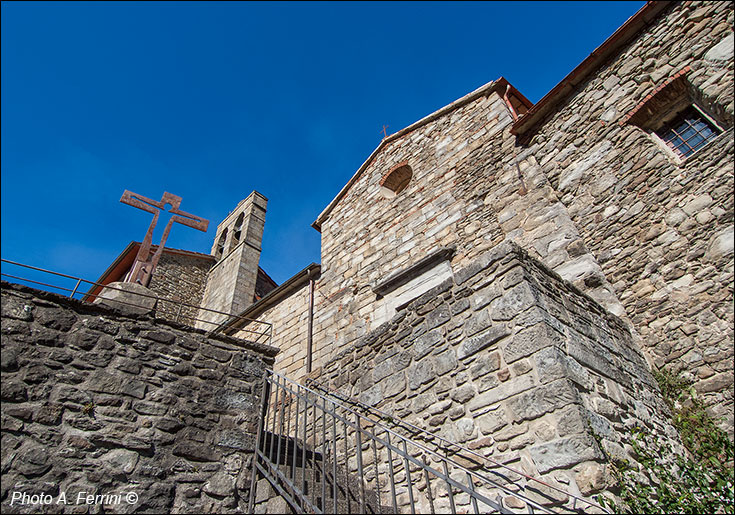Carda
in Casentino, una bella valle Toscana che puoi conoscere in ogni suo dettaglio con questo sito
Italiano
UNA SCALA PER GIUNGERE ALLA CHIESA
La Chiesa di Carda è un luogo interessante per l'arte che vi è conservata e per la storia che può narrare, una storia che va ben oltre il piccolo borgo di Carda. Il sacro e edificio è posto nella parte più alta del paese e si può piacevolmente raggiungere percorrendo alcuni vicoli e, all'ultimo, salire per la scala mostrata dalla foto. Oppure si può giungere alla chiesa dalla parte opposta, in questo caso in modo pianeggiante dopo aver aggirato il paese.
La chiesa di Carda è dedicata alle Sante Flora e Lucilla, per un preciso motivo storico che giunge a noi dall'XI secolo, periodo in cui il Vescovado di Arezzo donò Carda ai monaci della Badia di Santa Flora e Lucilla, non quella che si trova nel centro storico della città costruita nel XIII secolo, ma la prima badia aretina che sorse in un luogo ancor oggi non identificato, comunque nella zona Agazzi e Olmo.
Un rapporto tra Arezzo e Carda presupponeva un collegamento tra questi due luoghi. Quale era la strada? Quella di cui abbiamo fatto cenno a pagina 2 dove abbiamo visto Passo alla Forca. Da Carda si saliva a questo valico, si scendeva a Badia Santa Trinita da dove si proseguiva per Pontenano, poi verso il Passo della Crocina, il Poggio della Baselica (toponimo bizantino) da dove si scendeva a Castiglion Fibocchi passando dalla Pieve di San Quirico (Chiesa del Mille). Infine si giungeva ad Arezzo passando da Buriano (oggi Ponte Buriano).
The Church of Carda is an interesting place for the art that is preserved there and for the history that it can tell, a history that goes far beyond the small village of Carda. The sacred building is located in the highest part of the town and can be reached pleasantly by walking along some alleys and, at the end, climbing the stairs shown in the photo. Or you can reach the church from the opposite side, in this case on a flat path after going around the town.
The church of Carda is dedicated to Saints Flora and Lucilla, for a specific historical reason that comes to us from the 11th century, a period in which the Bishopric of Arezzo donated Carda to the monks of the Abbey of Santa Flora and Lucilla, not the one located in the historic center of the city built in the 13th century, but the first Arezzo abbey that arose in a place that is still unidentified today, however in the Agazzi and Olmo area.
A relationship between Arezzo and Carda presupposed a connection between these two places. What was the road? The one we mentioned on page 2 where we saw Passo alla Forca. From Carda you went up to this pass, you went down to Badia Santa Trinita from where you continued to Pontenano, then towards Passo della Crocina, Poggio della Baselica (Byzantine toponym) from where you went down to Castiglion Fibocchi passing by Pieve di San Quirico (Church of the Mille). Finally you reached Arezzo passing by Buriano (today Ponte Buriano).

















































